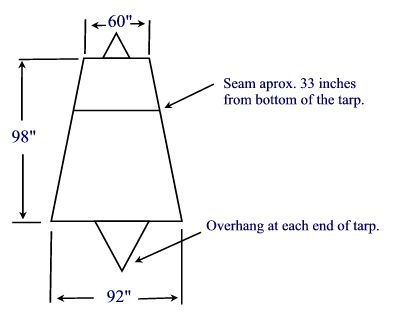
Since someone asked, here are my deviations from the Henry
Shires tarp/tent. Before my PCT hike, I made two of them. One for
me and the other for my son. I've been using and making tarptents for sometime
now. Henry's design is very similar to one I used on the AT in '97. I liked
the higher gap on one side of the tarp.
I had one I made for a '99 trip that was basically a lean-to tarp with
slight over hang. It was totally enclosed in netting. I used it successfully
in rain, but was unsure how it would do in a full downpour. Henry's design
was good compromise between the two.
Tarptents Design - Modifications from Henry Shires Tarptent Design.
-
 All measurements
are from the finished product. So allowances need to be made for sewing
purposes. They include Rear 60" , Front 94", Length 98". This provides
some additional room over Henry's. All measurements
are from the finished product. So allowances need to be made for sewing
purposes. They include Rear 60" , Front 94", Length 98". This provides
some additional room over Henry's.
-
Front height of tarp is 42", Rear height is 18". The tarp tent was keep
erect with two Easton poles, however, you could substitute hiking sticks.
-
With the larger space and higher roof, this tarp will sleep two complete
with gear.
-
The major tarptent seam runs across the width of the fabric instead of along
the ridge. The seam is sewn extra strong with 4 rows of stitching. The
last two rows of stitching go through 5 layers of material. The position
of the seam has two benefits.
-
First it requires less raw material to construct the tarp. So less waste.
This configuration requires 5 yards of raw stock not the 6 in Henry's design.
-
With the seam in the rear, any leaks that could form will be down toward
the back of the tarp. This keeps stuff at the front drier.
-
Weight is 24 oz's packed and ready to go. This includes 8 Easton stakes,
2 Easton shock-corded poles, guy lines, tarp and stuff sack.
-
Package size 14" X 3". I cut the poles down to provide a smaller packing
size. The tarp fits comfortably next to my sleeping bag at the bottom of
my Kelty Gale pack.
-
A slight overhang is added to both the front and rear of the tarp. This
provides a marginal deflection of falling rain.
-
Some additional finishing work not found in Henry's tent.
Setup:
-
Normally the tarp/tent is setup as a floorless tent. However it is flexible
enough to be setup in different configurations.
-
I used the tarp several times with a single pole in the back and the front
two tie downs stretched between two trees. If bugs aren't a problem, this
is a nice option. It provides plenty of ventilation and protection. I spent
a nice rainy evening with several people playing cards under the tarp configured
this way.
Performance:
-
In a 120 plus nights on the trail, the tarp was used about a dozen times.
On the rest of the occasions I slept under the stars.
-
In Southern California and Sierra's, when used, the tarp had quite a bit
of condensation. This required me to spread my stuff out during lunch to
dry. Generally not a problem but I was worried that over several rainy
days it might become a problem.
-
Further north, I started setting up the tarp in the alternate configuration.
I wanted to see if it would have any condensation problems. It didn't.
My son and I slept quite dry in a downpour in Oregon with the tarp in this
configuration. We didn't even bother setting up my son's tarp.
-
In Washington the tarp got a full workout. I started using it again in
it's default configuration and was surprised that I wasn't having any condensation
problems. Over several days of rain I stayed drier in my tarp than may
companions with their tents. One reason for this is because the with the
tarp, the ground cloth goes in after the tarp is setup and removed before
take down. This allows it to remain reasonably dry. The rest of the gear
can be packed before the tarp is put away.
-
On one occasion after hiking 26 miles with 5000 feet of climbing and descending
over two passes, in snow with two 10 minute breaks, I was able to test
out how waterproof the traps was. It was getting dark and we camped on
a small ledge just below three line with three tents. I wasn't able to
get it setup as well as I liked. In the morning the back half of the tarp,
with the seam, was flat against my sleeping bag. Crawling out of my tarp,
I found over a gallon of water puddle up on the tarp. None leaked through.
Copyright (C) 1999...2001 Ron "Fallingwater" Moak
|


